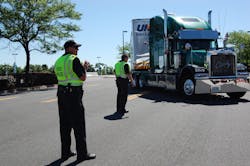Focus shifts to other safety issues following HOS decision
Following the ruling by the U.S. Court of Appeals for the District of Columbia Circuit last week largely denying petitions to vacate the hours-of-service (HOS) rules crafted by the Federal Motor Carrier Safety Administration (FMCSA) back in 2003, industry groups quickly turned their focus to other “more pressing safety and driver behavior issues,” in the words of Dave Osiecki, ATA senior VP of policy and regulatory affairs for the American Trucking Associations (ATA).
Sean McNally, the trade group’s VP of communications, told Fleet Owner that that some of those “more pressing issues” include: the use of electronic onboard recorders or EOBRs; driver fatigue management; and aggressive driving by motorists around large trucks.
“Obviously, we’re disappointed in the outcome,” McNally noted, in terms of the court’s decision to leave the bulk of current HOS regulations unchanged.
Yet he added that the group was cheered by the court’s decision to strike down a provision within the rules that required short-haul drivers to take 30-minute off-duty break. “Any small win is still a win,” McNally said.
FMCSA, though, dubbed itself “pleased” with the court’s decision. “The ruling recognizes the sensible data-driven approach that was taken in crafting this important regulation to increase safety and reduce driver fatigue – a leading factor in truck crashes,” the agency said in a prepared statement. “The ruling also provides added certainty for all affected, moving forward. [We are] reviewing the court’s opinion and will soon take additional action, as needed, for its full implementation.”
ATA’s Osiecki, though, told Fleet Owner he believes the agency could accomplish far more in terms of its safety efforts if it focused on better allocation of its enforcement resources.
“We’re not talking about FMCSA’s efforts to issue regulations regarding drug & alcohol testing, EOBRs, and other rules important to the industry,” he explained. “We’re talking about how they can change the focus on current programs to make bigger improvements in safety.”
For example, he pointed to FMCSA’s own analysis that showed while 88% of its enforcement resources focused on roadside inspection, with just 12% on traffic enforcement, focusing on traffic enforcement would be four and a half times more effective in terms of reducing crashes that lead to both fatalities and injuries.
“Another issue flying under the radar is FMCSA’s mandate under MAP-21 to create employer notification standards that help link driver violations – such as speeding, aggressive driving, etc. – back to carriers in state CDL databases,” Osiecki said. “Nobody is talking about that and we feel this is a ‘pressing issue’ in terms of improving safety.”
Along similar lines, the Owner-Operator Independent Drivers Association (OOIDA) noted shortly after the court’s ruling that it hopes to focus more closely on the issue of driver training – and issue Todd Spencer, the group’s executive VP, said has been ignored for far too long.
“As far as HOS, we have long believed that drivers need flexibility to do their jobs safely. That hasn’t changed. But the court’s decision has put the issue to bed for now,” Spencer noted. “That being said, hopefully we can now move on to addressing the biggest safety gap in the trucking industry and that’s the lack of basic training standards for new drivers.”
He added that OOIDA has launched a campaign dubbed Truckers for Safety to drum up more attention from Congress, federal agencies, and from within the trucking industry about driver training issues.
“Better trained drivers mean safer drivers,” Spencer explained. “An experienced career trucker is the type that people want to share the road with, and training should be the biggest focus of highway safety efforts.”
ATA’s Osiecki stressed, though, that the court also found “no merit” in the challenge to current HOS rules by a coalition of interest groups – led by petitioner Public Citizen – in an effort to reduce the driving day from 11 to 10 hours while eliminating the 34-hour restart provision altogether.
“The court also recognized on numerous occasions the shortcomings of the agency’s deliberations, so despite upholding most of the rule, we hope this opinion will serve as a warning to FMCSA not to rely on similarly unsubstantiated rulemakings in the future,” Osiecki said.
“ATA hopes FMCSA will work with the trucking industry to address more pressing safety and driver behavior issues, including those than can be directly affected through proven traffic enforcement activities aimed at unsafe operating behaviors,” he added.
About the Author
Sean Kilcarr
Editor in Chief
Sean Kilcarr is a former longtime FleetOwner senior editor who wrote for the publication from 2000 to 2018. He served as editor-in-chief from 2017 to 2018.
